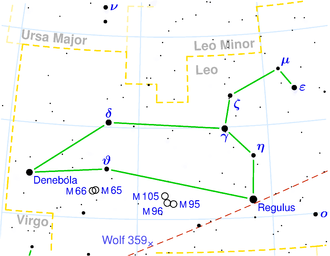NGC 3784
| Galaxie NGC 3784 | |
|---|---|
![NGC 3785 & NGC 3784 mit LEDA 213868(o)[1] SDSS-Aufnahme](http://upload.wikimedia.org/wikipedia/commons/thumb/1/1a/NGC3784_-_SDSS_DR14.jpg/300px-NGC3784_-_SDSS_DR14.jpg) | |
| NGC 3785 & NGC 3784 mit LEDA 213868(o)[1] SDSS-Aufnahme | |
| AladinLite | |
| Sternbild | Löwe |
| Position Äquinoktium: J2000.0, Epoche: J2000.0 | |
| Rektaszension | 11h 39m 29,8s[2] |
| Deklination | +26° 18′ 33″[2] |
| Erscheinungsbild | |
| Morphologischer Typ | SBb[2] |
| Helligkeit (visuell) | 14,4 mag[3] |
| Helligkeit (B-Band) | 15,3 mag[3] |
| Winkelausdehnung | 0,9′ × 0,3′[3] |
| Positionswinkel | 135°[3] |
| Flächenhelligkeit | 12,8 mag/arcmin²[3] |
| Physikalische Daten | |
| Zugehörigkeit | WBL 344[2] |
| Rotverschiebung | 0.022892 ± 0.000040[2] |
| Radialgeschwindigkeit | 6863 ± 12 km/s[2] |
| Hubbledistanz vrad / H0 | (305 ± 22) · 106 Lj (93,6 ± 6,6) Mpc [2] |
| Geschichte | |
| Entdeckung | Édouard Stephan |
| Entdeckungsdatum | 28. April 1881 |
| Katalogbezeichnungen | |
| NGC 3784 • PGC 36147 • CGCG 157-006 • MCG +05-28-006 • 2MASX J11392981+2618330 • NVSS J113929+261832 • LDCE 823 NED009 • HOLM 271A | |
NGC 3784 ist eine Balken-Spiralgalaxie vom Hubble-Typ SBa[3] im Sternbild Löwe an der Ekliptik. Sie ist schätzungsweise 305 Millionen Lichtjahre von der Milchstraße entfernt und hat einen Durchmesser von etwa 80.000 Lichtjahren. Gemeinsam mit NGC 3785 bildet sie das (optische) Galaxienpaar Holm 271.
Im selben Himmelsareal befinden sich u. a. die Galaxien NGC 3781 und NGC 3826.
Das Objekt wurde am 28. April 1881 vom französischen Astronomen Édouard Stephan entdeckt.[4]
Weblinks
Einzelnachweise
Auf dieser Seite verwendete Medien
Autor/Urheber: Sloan Digital Sky Survey, Lizenz: CC BY 4.0
The sky image is obtained by Sloan Digital Sky Survey, DR14 with SciServer.
Angle of view: 4' × 4' (0.3" per pixel), north is up.
Details on the image processing pipeline: https://www.sdss.org/dr14/imaging/jpg-images-on-skyserver/Autor/Urheber: Copyright © 2003 Torsten Bronger., Lizenz: CC BY-SA 3.0
This is a celestial map of the constellation Leo, the Lion.




